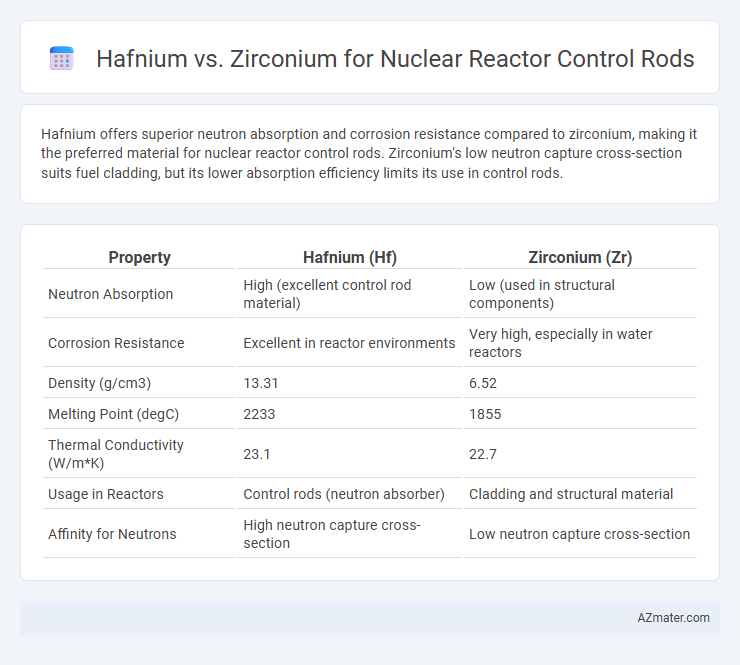Hafnium offers superior neutron absorption and corrosion resistance compared to zirconium, making it the preferred material for nuclear reactor control rods. Zirconium's low neutron capture cross-section suits fuel cladding, but its lower absorption efficiency limits its use in control rods.
Table of Comparison
| Property | Hafnium (Hf) | Zirconium (Zr) |
|---|---|---|
| Neutron Absorption | High (excellent control rod material) | Low (used in structural components) |
| Corrosion Resistance | Excellent in reactor environments | Very high, especially in water reactors |
| Density (g/cm3) | 13.31 | 6.52 |
| Melting Point (degC) | 2233 | 1855 |
| Thermal Conductivity (W/m*K) | 23.1 | 22.7 |
| Usage in Reactors | Control rods (neutron absorber) | Cladding and structural material |
| Affinity for Neutrons | High neutron capture cross-section | Low neutron capture cross-section |
Introduction to Nuclear Reactor Control Rods
Nuclear reactor control rods are critical components that regulate fission reactions by absorbing neutrons to maintain reactor stability. Hafnium and zirconium are key materials used in control rods due to their contrasting neutron absorption properties: hafnium exhibits excellent neutron absorption and corrosion resistance, making it ideal for control rod material. Zirconium, with its low neutron absorption cross-section and high strength, is typically used in reactor cladding rather than control rods, ensuring fuel integrity while minimizing interference with the nuclear reaction.
The Role of Hafnium and Zirconium in Nuclear Engineering
Hafnium exhibits exceptional neutron absorption properties, making it a critical material for control rods in nuclear reactors, where precise neutron flux regulation is essential for reactor safety and efficiency. Zirconium, with its low neutron absorption cross-section and high corrosion resistance, is primarily used in reactor claddings and structural components, ensuring durability under intense radiation and high-temperature conditions. The complementary roles of hafnium in neutron control and zirconium in structural integrity optimize nuclear reactor performance and longevity.
Physical and Chemical Properties Comparison
Hafnium exhibits superior neutron absorption cross-section compared to zirconium, making it more effective for nuclear reactor control rods. Physically, hafnium has higher density (13.31 g/cm3) and melting point (2233degC) than zirconium (6.52 g/cm3; 1855degC), contributing to greater durability under reactor conditions. Chemically, both metals resist corrosion, but hafnium's lower reactivity and stronger oxide layer enhance its stability in high-temperature, high-radiation environments within reactors.
Neutron Absorption Capabilities
Hafnium exhibits superior neutron absorption capabilities compared to zirconium, making it an ideal material for nuclear reactor control rods. Its high neutron capture cross-section effectively regulates the fission reaction by absorbing excess neutrons. Zirconium, on the other hand, possesses low neutron absorption properties, which is why it is primarily used as cladding material rather than for control rods.
Corrosion Resistance in Reactor Environments
Hafnium exhibits superior corrosion resistance in nuclear reactor environments compared to zirconium, primarily due to its dense oxide layer that effectively protects against high-temperature, neutron-rich conditions. Zirconium, while widely used in reactors for its low neutron absorption cross-section, tends to form less protective oxides, making it more susceptible to corrosion, especially in aggressive coolant environments like pressurized water reactors (PWRs). The enhanced corrosion resistance of hafnium ensures greater longevity and reliability in control rod applications where maintaining structural integrity is critical under prolonged irradiation and thermal stresses.
Mechanical Strength and Durability
Hafnium exhibits superior mechanical strength and exceptional corrosion resistance compared to zirconium, making it highly suitable for nuclear reactor control rods where durability under intense neutron irradiation is critical. Zirconium, while having lower neutron absorption cross-section, has less mechanical robustness and tends to suffer more from irradiation-induced embrittlement over time. The combination of high tensile strength and remarkable resistance to swelling and cracking under reactor conditions ensures hafnium's dominance in control rod applications despite its higher cost.
Availability and Cost Analysis
Hafnium and zirconium are essential materials for nuclear reactor control rods due to their neutron absorption properties, but hafnium is significantly rarer and more expensive than zirconium. Zirconium is more available globally, with extensive mining and processing infrastructure supporting its lower market price, making it the preferred material in large-scale reactor applications. Hafnium's higher cost stems from its scarcity and complex extraction processes, limiting its use to specialized applications where its superior neutron capture outweighs economic considerations.
Safety Considerations and Operational Impacts
Hafnium exhibits superior neutron absorption properties compared to zirconium, making it a safer and more effective material for nuclear reactor control rods in terms of neutron capture and reactivity control. Zirconium's low neutron absorption and high corrosion resistance are valuable for structural components, but its use in control rods is limited due to less efficient neutron absorption, which impacts operational control precision. Hafnium's high melting point and corrosion resistance under reactor conditions enhance the operational lifespan and reliability of control rods, contributing to safer reactor shutdown and emergency control scenarios.
Real-world Performance and Case Studies
Hafnium exhibits superior neutron absorption cross-section compared to zirconium, making it more effective for controlling reactivity in nuclear reactor control rods. Real-world performance in naval reactors, such as the U.S. Navy's nuclear submarines, demonstrates hafnium's durability and reliability under high neutron flux and extreme conditions, whereas zirconium is primarily used in fuel cladding due to its low neutron absorption. Case studies reveal that hafnium's corrosion resistance and mechanical strength sustain long-term reactor performance, emphasizing its critical role in safe and efficient reactor control systems.
Conclusion: Choosing Between Hafnium and Zirconium
Hafnium's superior neutron absorption cross-section makes it the preferred material for nuclear reactor control rods, ensuring efficient neutron capture and reactor safety. Zirconium, with its low neutron absorption and high corrosion resistance, is commonly used in reactor cladding rather than control rods. Selecting hafnium over zirconium for control rods optimizes reactor control and stability despite zirconium's advantages in other reactor components.

Infographic: Hafnium vs Zirconium for Nuclear Reactor Control Rod
 azmater.com
azmater.com